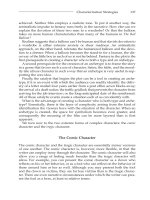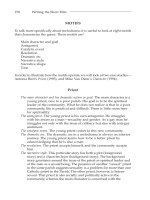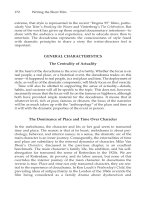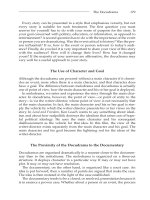Tài liệu Writing the short film 3th - Part 24 ppt
Bạn đang xem bản rút gọn của tài liệu. Xem và tải ngay bản đầy đủ của tài liệu tại đây (124.66 KB, 7 trang )
PA RT I I I
GENRES: FORMING
THE STORY
The term genre often conjures up images of gangsters, Western heroes, or
monsters. In fact, the term is applicable to all stories. Genre is nothing more
than the form, the envelope that encloses the characters and structure of the
story. Of course, gangster films, Westerns, and horror films are particular
genres. But so are war films, biographical films, science fiction films, and a
wide variety of comedies.
In this section of the book, we are going to look at four meta-genres, those
that transcend the more specific genres and yet include them. For example,
every sports film, every gangster film, every screwball comedy has in it a
layer of melodrama. Although we will be using long films to contextualize
the different genres, we will look only at meta-genres that are suitable to the
short film. These meta-genres embrace the particularities of the short film—
its relation to the short story and to the photograph—as well as the link of
the short film to nonnarrative forms such as poetry and abstract art.
Now we will turn to those meta-genres and show how they will be useful
to your writing a short film.
Ch13.qxd 9/27/04 6:10 PM Page 151
Ch13.qxd 9/27/04 6:10 PM Page 152
13
THE MELODRAMA
Perhaps it’s best to start this chapter with a bit of fact and fiction about melo-
drama. First the fiction.
Over the years, the term melodrama has increasingly taken on a negative
implication. It is associated with soap opera, exclusively with romantic
women’s stories, and with a dramatic device best characterized as exaggera-
tion (as opposed to realism, or a story that is simply more believable).
Although all of the above has a hint of truth, each is too narrow an approach
to melodrama and keeps us away from the usefulness of melodrama as a form.
Turning to the “truth” about melodrama, what then do we mean by the
term? A good starting point is to suggest that melodrama at its most basic
concerns itself with stories that are essentially realistic. Within that general
description, melodrama can be a story about ordinary people in ordinary sit-
uations as well as a domestic story about a king (Lear) or a prince (Hamlet).
Melodrama can be a relationship story of the privileged (James Cameron’s
Titanic) or of the famous (Michael Frayn’s Copenhagen). Melodramas can be
presented in the form of a novel (Judith Guest’s Ordinary People), a play
(Arthur Miller’s A View From the Bridge), or as a film (Joseph Mankiewicz’s
All About Eve). It can be a long film or a short one. Graham Justice’s A
Children’s Story and Elke Rosthal’s My Name Is Rabbit are both short films that
are melodramas. Both will be discussed later in this chapter.
GENERAL CHARACTERISTICS OF MELODRAMA
Realistic People in Realistic Situations
Melodramas, unlike fables, are stories that may have happened, or that at least
in the mind of the audience, could have happened. That means that the super-
natural and the fabulous are the subjects, or surroundings, of other genres. In
153
Ch13.qxd 9/27/04 6:10 PM Page 153
the melodrama, the story is about you or me, or our grandparents, or about
someone we believe exists or did exist. This recognizability affects every ele-
ment of the melodrama—its characters, its shape, its tone. Although not all
forms of drama are accurate renderings of reality (rather, they are exagger-
ated forms of reality), melodrama is essentially constrained by this notion of
recognizability and consequently believability.
To get more concrete, melodramas on television such as ER and Chicago
Hope focus on the lives of doctors and patients. Hospital bureaucracy, socie-
tal problems, love affairs, and the struggle for life are the story elements of
these successful series. The characters are well defined, differentiated, and
above all, very human. Hope, fear, passion, commitment, power, and pow-
erlessness define the characters and their goals. But key to our involvement
is that we in the audience know these people; they are you and me.
This quality of the melodrama is recognizable in the most highly
acclaimed films—Titanic, Shine, The English Patient. The subject matter of
these recent successes echoes the famous melodramas from the past.
Ambition is at the heart of All About Eve. Family violence is the core issue of
Lee Tamahori’s Once Were Warriors. The consequences of divorce are the sub-
ject of Robert Benton’s Kramer vs. Kramer. Racism is the core of Robert
Mulligan’s To Kill a Mockingbird, as it is of Euzhan Palcy’s A Dry White Season.
The key elements all these films share are that they treat the core issue
realistically, and the characters who inhabit the story are realistic.
The Dominance of Relationships as a Story Element
There are genres that are dominated by plot—the action-adventure film, the
Western, the war film. Other genres, such as melodramas, are dominated by
character. What this means is that melodramas key in on relationships on a
level that is both understandable and appealing to us.
In George Stevens’s A Place in the Sun (1952), the main character deeply
explores two love relationships, one with a working-class coworker, the
other with a privileged debutante. These relationships dominate the story. In
Peter Yates’s Breaking Away (1979), the main character explores his relation-
ships with his peers (a group of working-class mates who do not go to col-
lege) and a relationship with a privileged college student. In order to pursue
this latter relationship, he pretends to be a college student as well. To hide
more deeply his true identity from her, he also pretends to be Italian. In
Anthony Minghella’s Truly, Madly, Deeply, the main character struggles
between loyalty to a dead lover and the life-affirming urge to form a rela-
tionship with a man who is alive and capable of a future. Her struggle is very
much between remaining rooted in a tragic past and risking a viable future.
The character in Graham Justice’s A Children’s Story is a 10-year-old from a
154 Writing the Short Film
Ch13.qxd 9/27/04 6:10 PM Page 154
broken family. Her mother doesn’t have time for her, and the bus driver who
does have time for her is accused of sexually abusing her.
The Nature of the Main Character’s Struggle
Melodramas are marked by a very particular struggle for the main character.
Essentially it can be characterized as the struggle of a powerless main charac-
ter against the power structure. I should add that the definition of powerless-
ness has to be viewed in a very liberal way. For example, a king may be on the
surface very powerful, indeed all-powerful, but if he is as old as King Lear, he
will be faced with antagonists who are young, vibrant, and confident that they
are “the power structure.” In this sense, an aged King Lear is powerless.
A clearer example is the young child in a family drama. Relative to his
adult parents, the child is powerless. So too is a woman in a culture where
male dominance prevails. Thus, a story like Mike Nichols’s Working Girl is
one of a bright woman trying to make her way in a workplace that is a male
power structure. To complicate this story, Nichols places a high-status
woman at the head of the company. The main character’s working-class
roots make class the overlay to the female/male power grid. Consequently
the female, working-class main character has two layers of the power struc-
ture to contend with.
Whether the main character is dealing with gender, class, race, or age, the
key element to the melodrama is that the main character’s struggle is always
against the power structure. In genres such as the action-adventure and the
situation comedy, the plot enables the main character to achieve his or her
goal. In the melodrama, the plot is set against the main character and his or
her goal.
In Breaking Away, the bicycle race that concludes the film offers the main
character a chance to win the race, but in doing so he loses the college girl
with whom he was infatuated. To win he has to drop his pretense. No longer
a foreign student, no longer a college student, he acknowledges his working-
class self. He wins the race (plot) but loses the girl (goal).
The Adaptability of Melodrama
Although melodrama tends to be a character-driven proceeding, whether
without plot (Truly, Madly, Deeply) or with plot (A Place in the Sun), it is not
rigidly so. The form can be adapted if the story benefits. Specific examples
will illustrate.
George Miller’s Lorenzo’s Oil is a melodrama in which the mother and to
an extent, the father, initially believe they are powerless when their son is
The Melodrama 155
Ch13.qxd 9/27/04 6:10 PM Page 155









